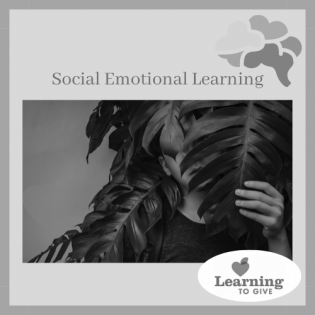SEL: Identity Self-Portrait
SEL Connection:
- Self-Awareness: integrate their personal and social identities and examine prejudices and biases
- Self-Management: identify diverse social norms, including unjust ones
- Social-Awareness: discuss ways to show respect for others related to their identities
Warm-Up
Note: It is important to read over activities before carrying out with youth. Preview and discuss the activity with a school counselor to be aware of any areas of sensitivity that may come up.
- Discuss the definition of identity: the distinguishing characteristics or personality of an individual; who a person is or what a thing is
- Reflect in writing: Write a list of some of your own identity markers, what distinguishes or makes up who you are.
- Watch this Identity short film. You may want to allow time to watch it a few times to build observation skills.
After viewing, discuss the following questions:
- How did you feel after watching this video?
- What moments in this film stood out for you? Why?
- Were there any surprises? Anything that challenged what you know — or thought you knew?
- What messages, emotions or ideas will you take away from this film? Why?
- What would make you feel comfortable removing a mask? What can you do to help others remove their masks?
- What symbols and colors would be on masks at your school? On your own mask?
- What questions do you still have?
Activity Instructions
- Each participant gets one copy of the Identity Portrait handout below.
- On one side, color your hair, skin tone, and clothing. You may call this your visible identity. These are the identity traits a stranger can see about you.
- On the other side, write and illustrate the identity markers that you are comfortable sharing. This might include interests, ethnicity, relationship preferences, gender, language, faith, heritage, abilities, and volunteer areas. You may call this your invisible identity.
- With one other person, share your portraits and talk about your visible and invisible traits. Pay attention to how it feels to talk about things people might not know about you.
Whole Group Discussion Questions
Ask participants to voluntarily share their identity portraits with the whole group and talk about what others might not know about them. When those that want to share are finished, have a group discussion:
-
What aspect of your identity is most valuable in the current setting?
-
What part of your identity do you often bring forward or wish people would pay more attention to?
-
In what ways do we make our invisible identities show more visibly?
-
Why would someone keep a specific identity hidden from others? Why might they bring an identity forward in only certain situations? Where are some places people highlight or hide their identities?
-
Why should we be conscious of our perceptions of others?
-
In what way can making assumptions be dangerous or disrespectful? What is premature judgment?
-
What prejudice and bias exists about specific identity traits?
-
How can we be respectful of everyone’s identity? What is a respectful or kind way to ask about an identity trait you aren't sure of?
Self Reflection Writing Prompts
- Write, draw, or use video or technology tools to show how you describe who you are to others. How has that changed over time? Make a diagram of parts of our identities that are fixed and those that change over time. What power do you have over your identity?
- Write about a time when you hid (or wanted to hide) a part of your identity from others? Why did you want that? What happened?
Wrap Up
- Organize a gallery walk for other youth to walk by and admire the portraits and leave connections on sticky notes.
- Display the portraits in a public space to raise awareness of our visible and invisible identities. Collaboratively come up with a question to display with the portraits to challenge viewers to think. Be sure to get permission from the portrait artists and the owner of the space.
Extension
- View and discuss this video about Prejudice. How can awareness of our premature judgment help us be more inclusive?
- Read and discuss the book Just Ask by Judge Sonia Sotomayor.
- Following the symbolism in the Identity video above, young people may make a mask that portrays their outward and peer-centered identities. Alternatively, the mask may symbolize their inner identity.
